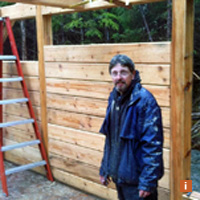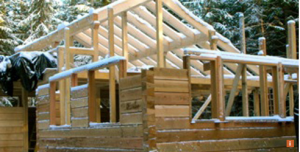A Cabin Takes Shape as Foresters Restore Wildlife Habitat
By Dustin Solberg
This spring a crew of carpenters will sweep the last of the winter snows from their sawhorses, ready for Alaska’s building season to begin. Though days are long, the summer is short – there’s no time to waste.
Bill and Carolyn Thomason, who own a small sawmill in the rainforest of Prince of Wales Island in the Alaska panhandle, are resuming work on a log cabin in a picturesque little town in Alaska. But the story of this home began long before carpenters hammered the first nail.
It begins at a place known as Winter Harbor, where the Tongass National Forest meets the sea.
This is where the Thomason crew cut the Sitka spruce logs over the course of three summers. He hauled them to his log yard, where they were piled neatly until he milled them into squared-off building timbers.

Much like a gardener knows where the salad on her plate comes from, you might say Thomason knows the precise origin of this wood. With a similar precision, he understands his business niche: milling specialty products from select young-growth trees from areas of the Tongass National Forest that were first logged many decades ago.
“We don’t see ourselves as trailblazers, we’re just doing what we need to do,” he says.
Where the Log Cabin Begins
The Tongass is the nation’s largest national forest and it’s home to some of the nation’s biggest trees. Like a great cathedral, these forests can inspire. The Tongass National Forest is laced with salmon streams, and these waters, incredibly, produce almost one-third of the U.S. commercial wild salmon catch.
The Tongass also produces prized wood. Yellow-cedar. Western red cedar. Western hemlock. And lastly, Sitka spruce: a strong and lightweight material that, in the era before aluminum, was used in airplane construction. Luthiers build guitars and other stringed instruments from clear-grained panels milled from Sitka spruce, and these choice trees are known as musicwood. It’s commonly used for lumber, too.
Keeping these forests and streams healthy while sustaining a local timber industry requires a balanced approach to forestry. The timber industry has had a prominent role in the development of Southeast Alaska over the last half-century. Logging in old-growth forests brought jobs and more people to this remote region of Alaska, but early timber practices weren’t always sound. Until the Tongass Timber Reform Act of 1990, forests were often logged right down to the edge of salmon streams. Now, an increasing focus on watershed health and second-growth forest management is leading to jobs for local people and better fish and wildlife habitat.
You might say this log cabin began as an afterthought. Its logs are actually the useful byproduct of a wildlife habitat restoration project designed to bring sunlight – the all-important ingredient for life – back to the floor of this second-growth forest.
“The regeneration in Southeast Alaska is prolific,” says Keith Rush, the Conservancy’s conservation forester in Alaska. “Trees grow back naturally – no replanting is required.”
And therein lies the challenge.
“The trees grow so thick, the crowns of the trees will intersect each other and this stops sunlight from penetrating to the forest floor,” Rush says.
Several thousand trees can spring up in the space of a single acre. (That’s nearly as large as a football field, not including the end zones.) In contrast, the open mosaic of an old-growth forest may have just 100 trees in the same space.
So when a forester cruises a forest with an eye for restoring it, he’s thinking like a windstorm. Why a windstorm?
In the wet forests of the Tongass, unlike the more arid forests of the American West, death comes not by fire, but by wind.
“Mortality happens,” Rush says. “Clumps of trees will get blown over by wind. That’s the primary agent of change in Southeast.”
The return of sunlight ushers in a cascade of healthy changes in the second-growth forests of the Tongass. It warms the forest soil, where a bank of dormant seeds lies in wait. Shrubs like blueberries and an array of wildflowers spring to life once light returns, creating food for Sitka black-tailed deer. The deer, in turn, are prey for the Alexander Archipelago wolf. For families, hunting deer is an important part of a local subsistence tradition. In short, restoring sunlight to the forest floor contributes to a dynamic food web in which each member has a role.
Change is in the Air

Thomason’s 1,000-square-foot log cabin, situated on a quiet road in the town of Gustavus, Alaska, will be a snug and comfortable home. It’s also a tangible example of how an enterprising small business can use second-growth forests to its advantage.
“This cabin is representative of the potential of second-growth timber, given time,” Rush says.
People will need to be involved in bringing back forest habitat, and this will yield timber for market. The time to start gearing up for the transition toward logging second-growth is now.
“In a couple decades, there will be thousands of acres of stands that will be a similar age to the Winter Harbor stand. You’ve got to get things figured out before then. The project that produced the logs for this cabin helps do that,” Rush says.
The Tongass National Forest has already begun a transition toward logging and managing young-growth forests for a range of values.
It’s a transition the Conservancy supports. The agency is paying more attention to protecting and improving vital fish and wildlife habitat, and creating jobs via a more diversified and stable economy.
“The exciting story in the transition is the fact that there is an opportunity to improve wildlife habitat and grow a second-growth industry,” Rush says.
It’s a future for nature and people.
“Jobs need to be dependable so that people feel like they can buy a home and raise their families here,” says the Conservancy’s Michael Kampnich, a logger-turned-commercial fisherman who raised his family on Prince of Wales Island. “We have a real opportunity here. I believe the best days of the industry may still be in front of us.”
The Nature Conservancy is the leading conservation organization working around the world to protect ecologically important lands and waters for nature and people.




